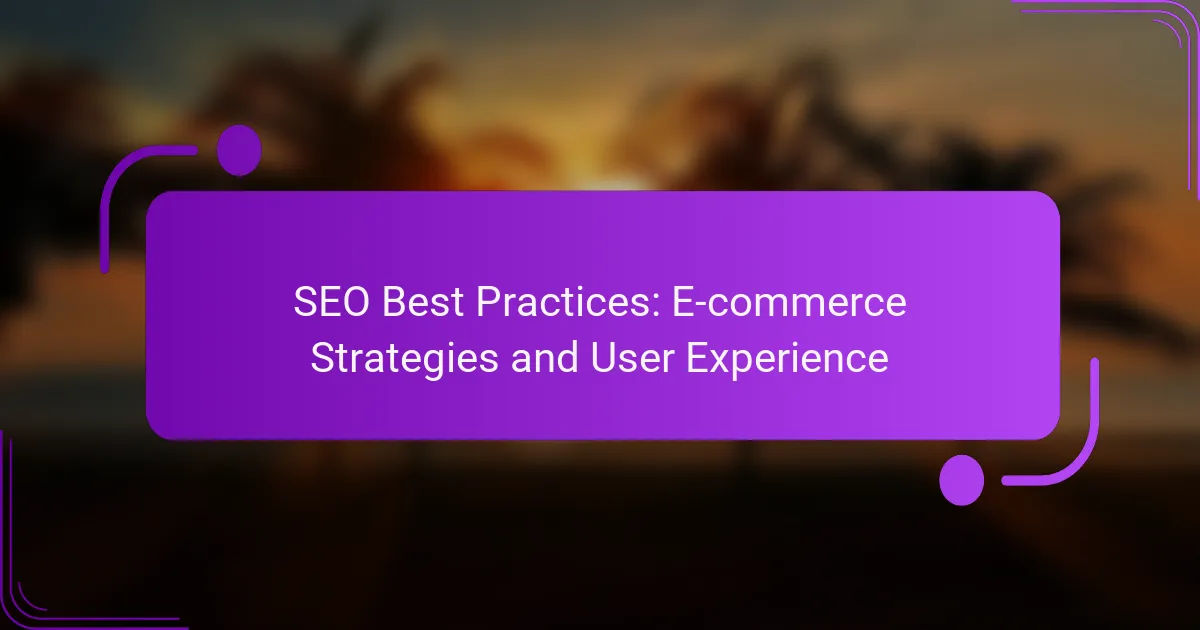In the competitive landscape of e-commerce, implementing effective SEO strategies is crucial for enhancing visibility and improving user experience. By focusing on targeted keyword optimization, content marketing, and technical practices, online retailers can drive qualified traffic and boost search rankings. Additionally, prioritizing user experience fosters engagement and encourages longer visits, ultimately leading to increased conversions.
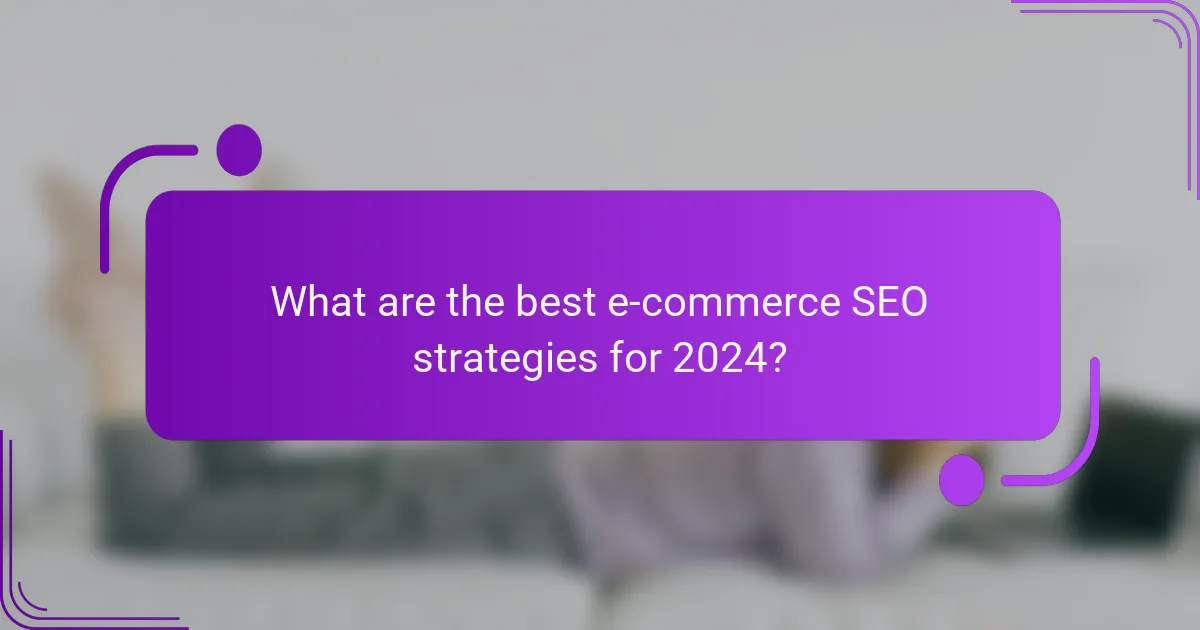
What are the best e-commerce SEO strategies for 2024?
The best e-commerce SEO strategies for 2024 focus on enhancing visibility and user experience through targeted keyword optimization, effective content marketing, and robust technical practices. Implementing these strategies can significantly improve search rankings and drive more qualified traffic to your online store.
Keyword optimization techniques
Keyword optimization is essential for e-commerce SEO, as it helps align your product offerings with user search intent. Start by conducting thorough keyword research to identify high-volume and relevant terms, including long-tail keywords that reflect specific product features or customer needs.
Utilize these keywords in key areas such as product titles, descriptions, and meta tags. Avoid keyword stuffing; instead, aim for a natural flow that enhances readability while still targeting your desired terms. Regularly update your keyword strategy based on search trends and performance analytics.
Content marketing for product pages
Effective content marketing for product pages involves creating engaging and informative content that resonates with potential buyers. This includes detailed product descriptions, high-quality images, and user-generated content like reviews and testimonials, which can build trust and encourage conversions.
Consider adding blog posts or guides related to your products to enhance SEO and provide value to customers. This not only improves search visibility but also positions your brand as an authority in your niche, driving organic traffic to your site.
Mobile optimization practices
With a significant portion of online shopping occurring on mobile devices, mobile optimization is critical for e-commerce success. Ensure your website is responsive, meaning it adapts seamlessly to different screen sizes, providing a user-friendly experience on smartphones and tablets.
Optimize loading speeds by compressing images and minimizing code. Implement mobile-friendly navigation and checkout processes to reduce friction and improve conversion rates. Regularly test your site on various devices to identify and fix any usability issues.
Technical SEO improvements
Technical SEO improvements focus on the backend of your website to enhance its performance and crawlability. Start by ensuring your site has a clean URL structure, proper use of header tags, and an XML sitemap submitted to search engines.
Implement SSL certificates for security, as this is a ranking factor for Google. Regularly audit your site for broken links, duplicate content, and page speed issues, as these can negatively impact both user experience and search rankings.
Local SEO tactics for online stores
Local SEO tactics are crucial for e-commerce businesses targeting specific geographic areas. Create and optimize a Google My Business listing to improve visibility in local search results. Include accurate information such as your business name, address, phone number, and operating hours.
Incorporate local keywords into your website content and meta tags, and encourage customers to leave reviews. Engaging with local communities through events or sponsorships can also enhance your local presence and drive traffic to your online store.

How can user experience enhance e-commerce SEO?
User experience (UX) significantly boosts e-commerce SEO by improving site engagement and reducing bounce rates. A seamless and enjoyable shopping experience encourages visitors to stay longer, leading to higher search engine rankings and increased conversions.
Importance of website speed
Website speed is crucial for e-commerce SEO, as slow-loading pages can frustrate users and lead to abandoned carts. Aim for page load times under three seconds, as studies show that even a one-second delay can decrease conversions by a notable percentage.
To enhance speed, optimize images, leverage browser caching, and minimize HTTP requests. Tools like Google PageSpeed Insights can help identify areas for improvement.
Navigation and site structure
A clear navigation system and logical site structure are essential for both user experience and SEO. Users should easily find products and information without excessive clicks. Implement a hierarchical structure with categories and subcategories to guide visitors effectively.
Consider using breadcrumb navigation to help users track their location within the site. This not only improves usability but also enhances search engine crawling and indexing.
Responsive design benefits
Responsive design ensures that your e-commerce site functions well on various devices, including desktops, tablets, and smartphones. With mobile commerce on the rise, a mobile-friendly site is critical for capturing a broader audience and improving SEO rankings.
Google prioritizes mobile-friendly sites in search results, so use responsive design techniques to adapt content and layout based on screen size. Regularly test your site on multiple devices to ensure a consistent user experience.
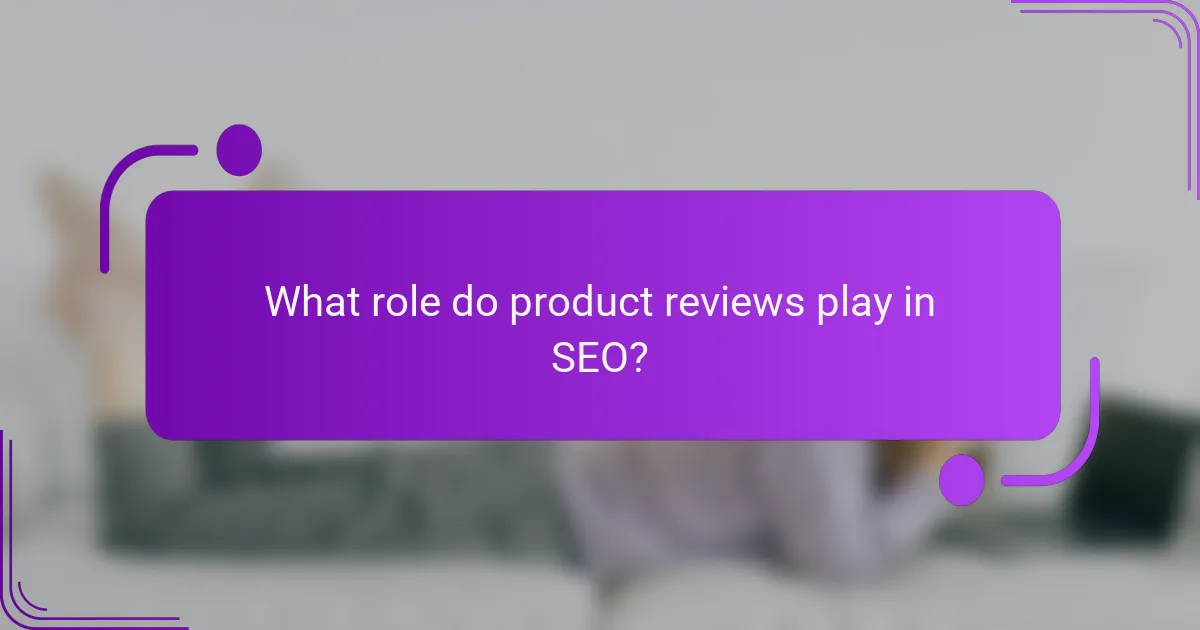
What role do product reviews play in SEO?
Product reviews significantly enhance SEO by providing fresh, user-generated content that search engines favor. They not only improve visibility in search results but also build trust with potential customers, which can lead to higher conversion rates.
Impact on search rankings
Product reviews can positively influence search rankings by increasing the amount of relevant content associated with a product. Search engines prioritize pages with rich, varied content, and reviews contribute to this by incorporating keywords that potential buyers use in their searches.
Additionally, products with numerous reviews often rank higher due to the perceived authority and trustworthiness they convey. Pages with high engagement metrics, such as time spent reading reviews, can further boost rankings.
Encouraging customer feedback
Encouraging customers to leave reviews can be achieved through various strategies, such as follow-up emails after a purchase or incentives like discounts on future purchases. Making the review process simple and accessible can significantly increase participation rates.
Consider implementing a review system that prompts users to share their experiences shortly after receiving their products. This not only increases the volume of reviews but also ensures that the feedback is fresh and relevant, which is beneficial for SEO.
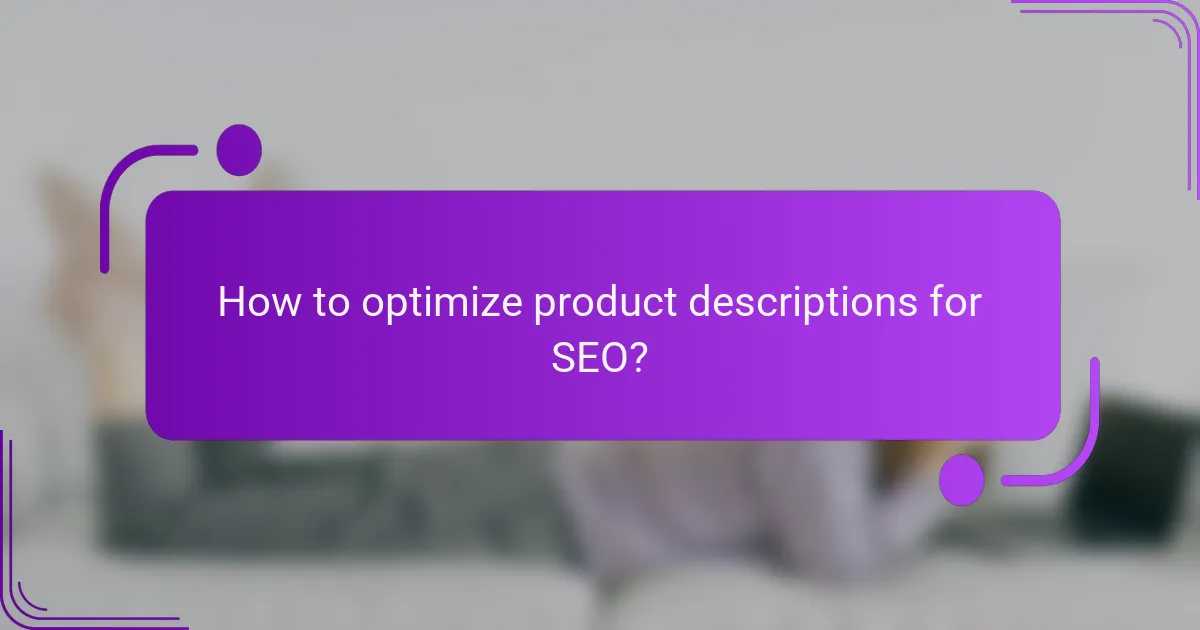
How to optimize product descriptions for SEO?
To optimize product descriptions for SEO, focus on creating engaging, informative, and unique content that accurately reflects the product while incorporating relevant keywords. This approach not only enhances visibility in search engines but also improves user experience, leading to higher conversion rates.
Using unique content
Unique content is essential for SEO as it helps differentiate your products from competitors. Avoid copying manufacturer descriptions or using generic text; instead, craft original descriptions that highlight the unique features and benefits of each product. This can include specific details about materials, usage, or customer testimonials.
Consider using storytelling techniques to make descriptions more engaging. For example, instead of simply stating that a jacket is waterproof, describe how it keeps you dry during a rainstorm while hiking. This approach not only informs but also connects with potential buyers on an emotional level.
Incorporating keywords naturally
Incorporating keywords naturally into product descriptions is crucial for improving search engine rankings. Identify relevant keywords that potential customers might use when searching for your products, and integrate them seamlessly into your descriptions. Aim for a keyword density of around 1-2% to avoid keyword stuffing, which can harm your SEO efforts.
Use variations of your primary keywords to capture a broader audience. For instance, if your main keyword is “running shoes,” consider including related terms like “athletic footwear” or “jogging sneakers.” This strategy not only enhances SEO but also ensures that your content remains readable and engaging for users.
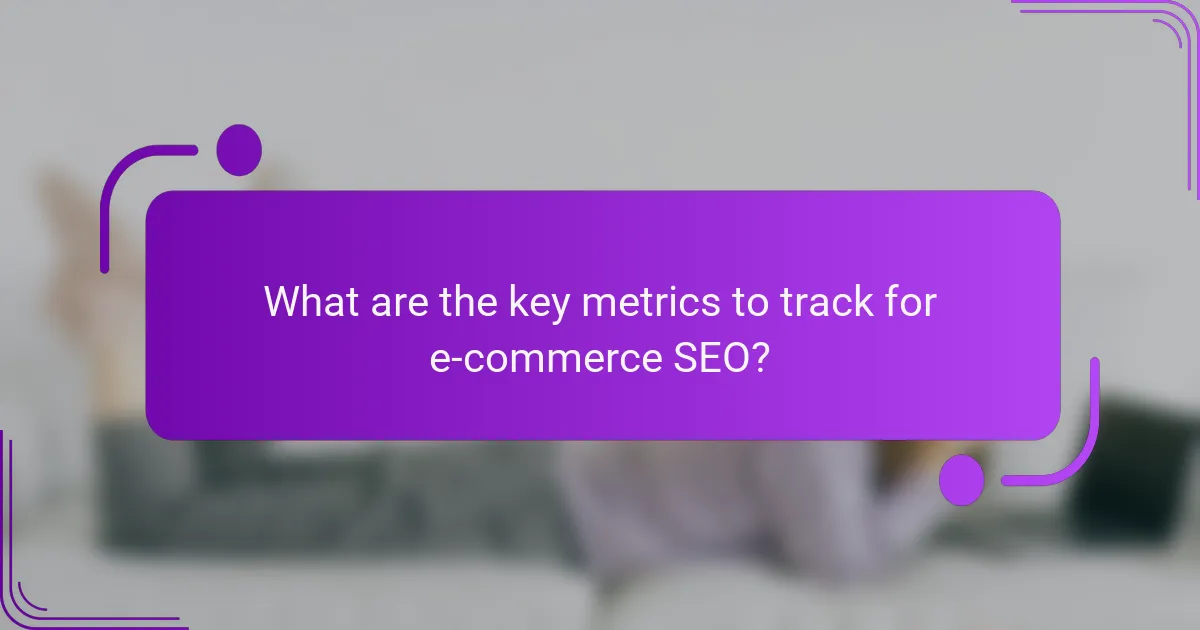
What are the key metrics to track for e-commerce SEO?
Key metrics for e-commerce SEO include organic traffic, conversion rates, and bounce rates. Monitoring these metrics helps identify strengths and weaknesses in your online store’s performance, guiding improvements to enhance user experience and drive sales.
Organic traffic analysis
Organic traffic analysis involves tracking the number of visitors arriving at your e-commerce site through search engines. This metric is crucial as it indicates how well your SEO strategies are performing in attracting potential customers.
To analyze organic traffic effectively, use tools like Google Analytics to monitor trends over time. Look for fluctuations that may correlate with changes in your SEO tactics, content updates, or algorithm changes. Aim for steady growth in organic visitors, ideally in the range of 10-30% year-over-year.
Conversion rate optimization
Conversion rate optimization (CRO) focuses on improving the percentage of visitors who make a purchase. A higher conversion rate indicates that your site effectively persuades visitors to complete transactions.
To enhance your conversion rates, consider A/B testing different elements such as product pages, checkout processes, and call-to-action buttons. Typical conversion rates for e-commerce sites range from 1-3%, but optimizing user experience can push this higher. Ensure your site is mobile-friendly, as a significant portion of e-commerce traffic comes from mobile devices.
Bounce rate insights
Bounce rate measures the percentage of visitors who leave your site after viewing only one page. A high bounce rate may suggest that your content or user experience is not engaging enough to encourage further exploration.
To reduce bounce rates, ensure your landing pages are relevant and provide clear value to visitors. Aim for a bounce rate below 40%, but remember that this can vary by industry. Use tools like Google Analytics to identify pages with high bounce rates and analyze user behavior to make necessary adjustments.
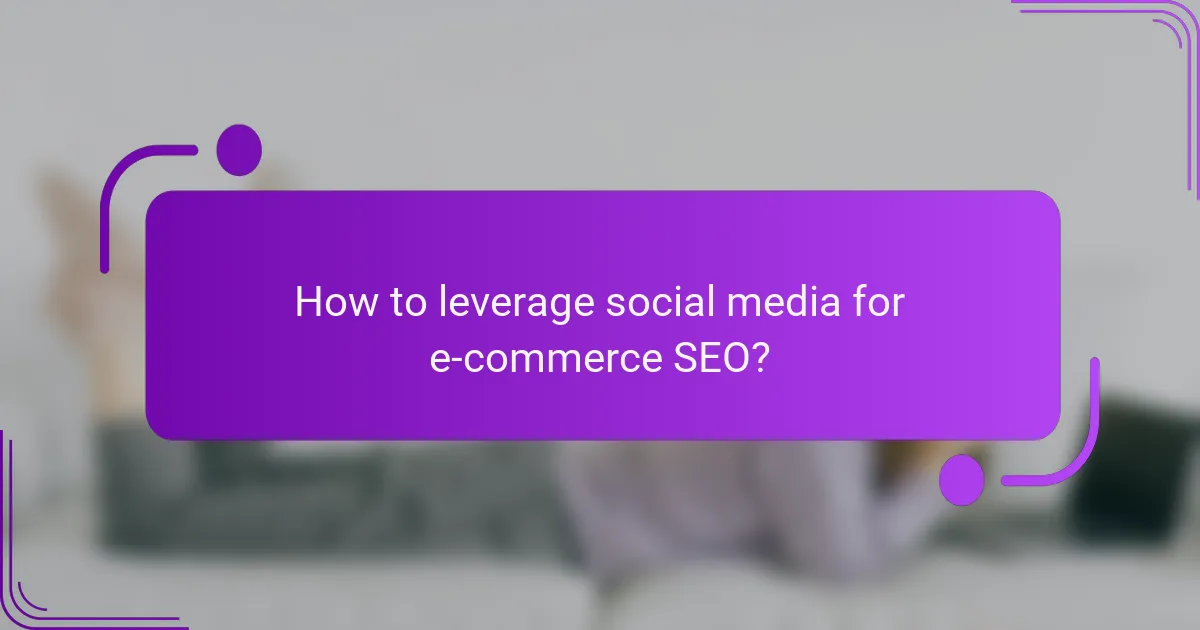
How to leverage social media for e-commerce SEO?
Leveraging social media for e-commerce SEO involves using social platforms to enhance your online visibility and drive organic traffic. By creating engaging content and building a community, you can improve your search rankings and attract more potential customers.
Building brand awareness
Social media is a powerful tool for building brand awareness in the e-commerce space. Regularly posting high-quality content that resonates with your target audience can help establish your brand identity and foster recognition. Use visuals, such as images and videos, to make your posts more engaging and shareable.
Consider running targeted ad campaigns on platforms like Facebook and Instagram to reach specific demographics. These ads can increase visibility and introduce your brand to new audiences, which is essential for long-term growth.
Driving traffic through social platforms
To effectively drive traffic from social media to your e-commerce site, include clear calls-to-action (CTAs) in your posts. Encourage users to visit your website for exclusive offers or new product launches. Shortened links can help track the effectiveness of your campaigns.
Engagement is key; respond to comments and messages promptly to build relationships with your audience. Collaborating with influencers can also amplify your reach, as they can introduce your products to their followers, driving additional traffic to your site.
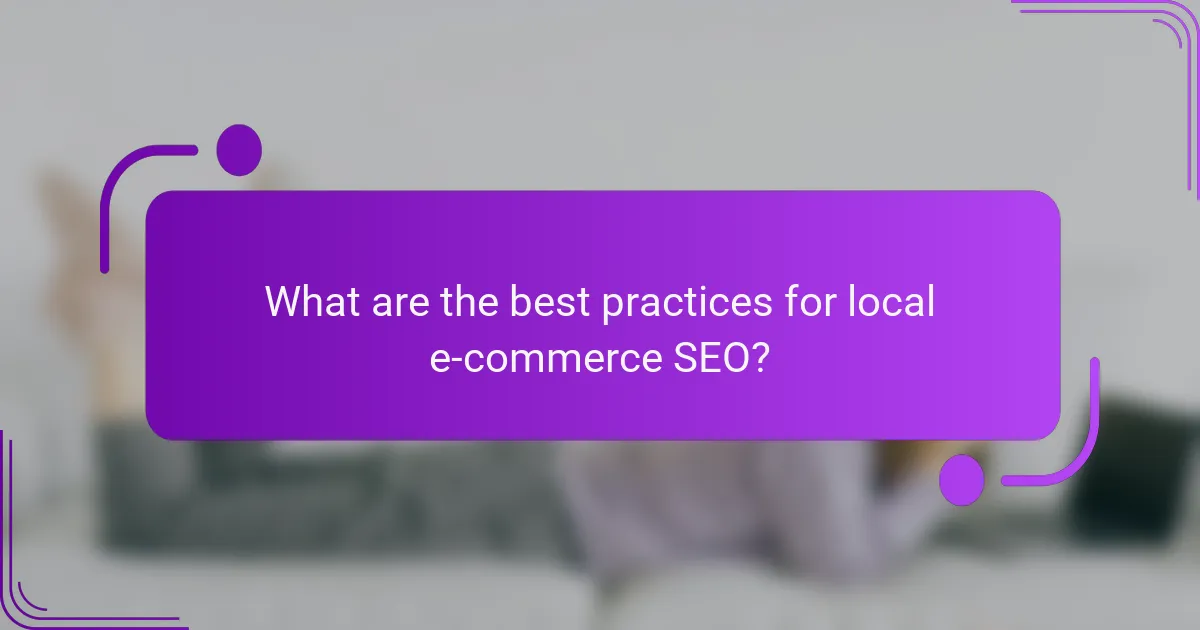
What are the best practices for local e-commerce SEO?
Effective local e-commerce SEO practices focus on optimizing your online store for local search visibility. This involves using location-specific keywords, ensuring accurate business listings, and enhancing user experience to attract and retain local customers.
Optimize your website for local keywords
Incorporating local keywords into your website content is crucial for local e-commerce SEO. Use tools like Google Keyword Planner to identify relevant terms that include your city or region. For example, if you sell shoes in Boston, phrases like “Boston shoe store” or “buy shoes in Boston” should be integrated into product descriptions, titles, and meta tags.
Additionally, consider using long-tail keywords that reflect local search intent. These often have lower competition and can drive more targeted traffic. For instance, “best running shoes for women in Boston” can attract customers specifically looking for that product.
Claim and optimize your Google Business Profile
Claiming and optimizing your Google Business Profile is essential for local visibility. Ensure that your business name, address, phone number, and website URL are accurate and consistent across all platforms. This consistency helps Google verify your business’s legitimacy and improves your chances of appearing in local search results.
Enhance your profile by adding high-quality images, responding to customer reviews, and posting updates about promotions or events. Regular engagement can improve your ranking in local searches and attract more foot traffic to your physical location.
Utilize local backlinks
Building local backlinks is an effective strategy to boost your local e-commerce SEO. Reach out to local businesses, bloggers, and community organizations to collaborate on projects or events that can earn you mentions and links. For example, sponsoring a local charity event can provide valuable exposure and backlinks from their website.
Additionally, consider submitting your site to local directories and industry-specific listings. Ensure that these backlinks are from reputable sources to enhance your site’s authority and improve your search rankings.
Enhance user experience on mobile
With a significant number of local searches conducted on mobile devices, optimizing your e-commerce site for mobile users is vital. Ensure your website is responsive, loads quickly, and provides a seamless shopping experience on smartphones and tablets. Aim for load times under three seconds to reduce bounce rates.
Implement mobile-friendly features such as easy navigation, large buttons, and clear calls-to-action. Providing a smooth checkout process on mobile can significantly increase conversion rates among local customers.
